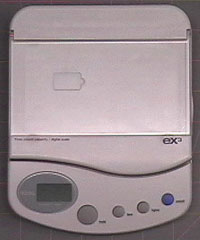Other Measuring Instruments
These items are nice to have, but you certainly do not need them.
A set of drafting dividers is excellent
for transferring dimensions without using any type of a rule. In fact, it
is generally more accurate if used properly. A divider looks a lot like a
compass but has two points instead of a lead. They can be purchased at
most art stores.
The rectangular thing with all the holes in it shown in the image above is a
wire gauge. I bought mine a couple years ago. When I can not read the size on my drill bits I can find
out exactly what size they are.
 My caliper is
metric and mainly used with my
helicopter. I am finding more uses for it,
but I do not really have enough experience with them to discuss them
intelligently. I have a vague idea how to read them and that is as much as
I have figured out. My caliper is
metric and mainly used with my
helicopter. I am finding more uses for it,
but I do not really have enough experience with them to discuss them
intelligently. I have a vague idea how to read them and that is as much as
I have figured out.
A good postal scale will help you select wood for your projects.
Something up to about 2 or 3 lbs is fine. Scales are most accurate in
the middle of their range, so you want to ensure that the scale you buy
is not of a capacity significantly higher than what you will be measuring.
For example, a baby scale would be really inaccurate if used to weigh a
sheet of balsa.
However, a baby scale is excellent for weighing finished models.
I doubt they are accurate to more than a few ounces, but they'll get you in
the ball park. If you need a very accurate measurement then you will
need something else. I would think that a good fish scale would
be accurate considering how seriously fishermen take their sport.
What I consider the most important feature for a scale is consistency.
If I put a piece of wood on and the scale indicates that it weighs 28 grams,
then I want it to say 28 grams each of the next ten times I put the same piece
of wood back on. Even if that figure isn't perfectly accurate, it allows
me to grade my wood and determine how the weights of the various pieces compare.
This isn't just to find the lightest piece, but also to match pieces.
For example, you really want your wings to balance as much as possible. An
unbalanced wing won't trim until it does balance. If you match your wood
and are consistent in how you build, then the wing will not require too much
ballast to bring it into balance.
|
![]()